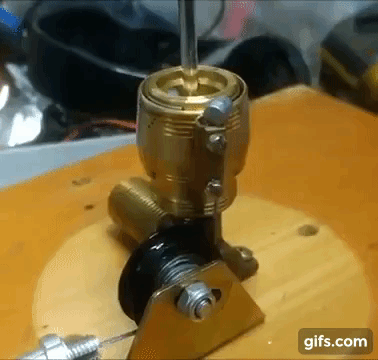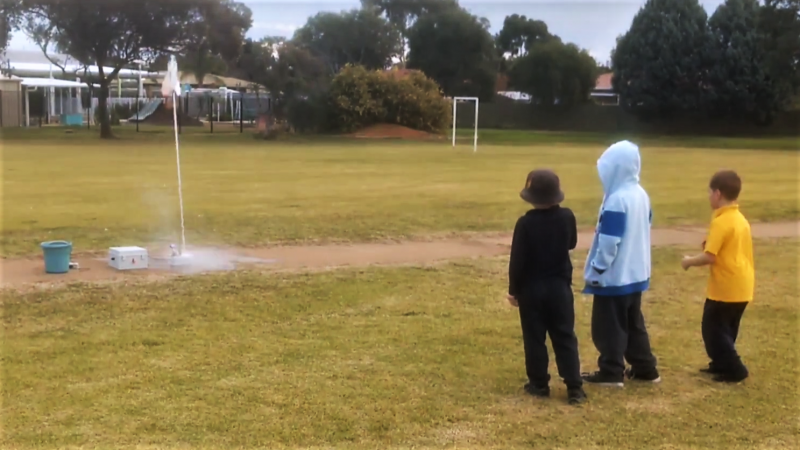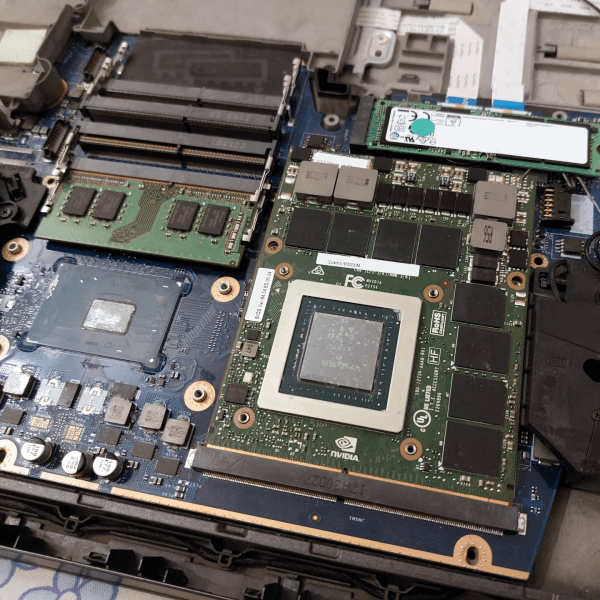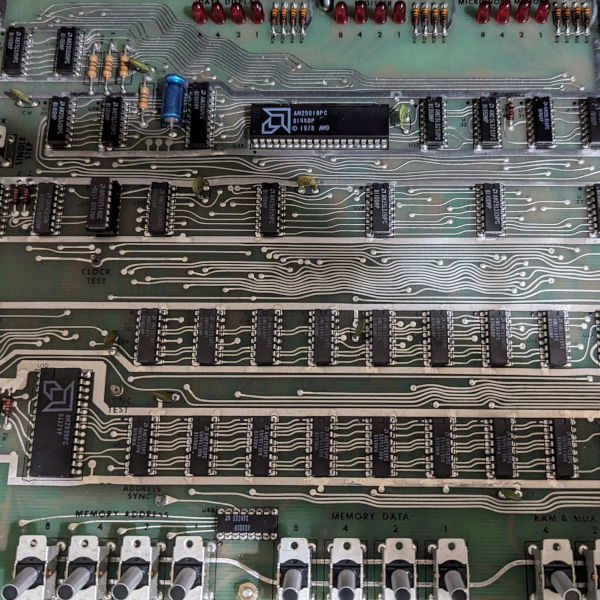We have fond memories of air-water rockets, which were always a dime store purchase for summertime fun in the pool. Despite strict guidance from mom to shoot them only straight up, the first target was invariably a brother or friend on the other side of the pool. No eyes were lost, and it was good clean fun that was mercifully free of educational value during summer break.
 But now a teacher has gone and ruined all that by making an air-water rocket launching pad for his STEM students. Just kidding — [Robert Hart] must be the coolest teacher in Australia when Friday launch days roll around. [Mr. Hart] wanted a quick and easy way to safely launch air-water rockets and came up with a pretty clever system. The core task is to pump air into the partially filled water bottle and then release it cleanly. [Robert] uses quick-disconnect fittings, with the female coupling rigged to a motor through a bicycle brake cable. The control box has a compressor, the release motor, and a wireless alarm remote, all powered by a 12-volt battery. With the male coupling glued to the cap of a bottle acting as a nozzle and a quick, clean release, flights are pretty spectacular.
But now a teacher has gone and ruined all that by making an air-water rocket launching pad for his STEM students. Just kidding — [Robert Hart] must be the coolest teacher in Australia when Friday launch days roll around. [Mr. Hart] wanted a quick and easy way to safely launch air-water rockets and came up with a pretty clever system. The core task is to pump air into the partially filled water bottle and then release it cleanly. [Robert] uses quick-disconnect fittings, with the female coupling rigged to a motor through a bicycle brake cable. The control box has a compressor, the release motor, and a wireless alarm remote, all powered by a 12-volt battery. With the male coupling glued to the cap of a bottle acting as a nozzle and a quick, clean release, flights are pretty spectacular.
There are many ways to launch an air-water rocket, from the simple to the complex. [Robert]’s build leans toward the complex, but looks robust enough for repeated use and makes the launch process routine so the kids can concentrate on the aerodynamics. Or to just enjoy being outdoors and watching things fly.

















STEM?………… ]:-)
Nice build.
I thought the same thing.
I’m also hoping that nobody suggests heating the water used to launch the rocket.. because then misunderstanding and comment-storm!
But seriously, it’s STEM. No need for any other letters. The video from Dankula in the other story was spot on.
Science Technology Engineering and Mathematics
Science, Technology, Engineering and Mathematics ??
Kinda like the 3 R’s…. Readin, riting, and rithmetic.
Science Technology Engineering And Mathematics… STEAM confirmed!
Thank guys nice review.
Hi Robert. This is awesome! Do you plan to post detailed build plans for this?
Good start for some kids, Really liked that your electric fidget spinner session video appeared to be largely self driven and contained no production spinners. ;) Keep up the great work.
Apologies for the poor video production quality. If you have tried to filming anything with a phone camera while watching over 20 young students, you’ll know the challenges. I’ll document more how to make it, when I have the time. But I’m currently focused on my hackaday prize entry and art installation. I’m a “maker” not a youtuber. https://hackaday.io/project/16568-cosmic-array
+1 for holding the phone the correct way!
…and for encouraging more people to drop their gadgets and build something.
That got their attention, now to talk to them about the ideas behind it such as pressure, mass and velocity. :-) As for the maths, well that depends on their age but mentioning that you need maths to make rockets is a good motivator.
Neat, I particularly like the repurposed garden hose connectors as the quick-release mount.
I know geeks have trouble with social skills such talking to people, but those two videos are dreadful. No voice over explaining, just video snippet after video snippet.
I’ll be blunt. I’d not going to bother to watch and rewatch something trying to make up for that lack of commentary. If you want people to understand how this air-water rocket was built, explain…. like in spoken words or at least captions. And if you have trouble with that, get someone who doesn’t to help.
Found the artist ;) Seriously Robert the videos are fine for what they demo – getting kids interested in STEM. Now go find us the next Arthur Richard Newton or Cheryl Praeger.
KISS ….
DANGER HaD… “STEM” (Science, Technology, Engineering, & Mathematics) has been DEPRECATED by Political Correctness (PC). It is now “STEAM” (Science, Technology, Engineering, ARTS, & Mathematics)! Check your “Privilege” HaD!
Be VERY careful HaD. It’s “STEAM” now, not “STEM”. If you don’t Comply “they” will come and BURN your house down. Definitions:
https://en.wikipedia.org/wiki/STEM
https://en.wikipedia.org/wiki/STEAM_fields
Quoting from the above “STEAM” reference:
“STEAM programs add art to STEM curriculum by drawing on design principles and encouraging creative solutions”
Gee, I’m a long-time practicing Engineer (EE). I’ve always considered Engineering to be a mix of both Art (Unbounded Creativity) and Science (be Careful, or you will Blow Yourself Up!) At-least that’s what I was taught when years of Engineering School modified my Brain forever.
So what happened to Common-Sense in our Society? Is EVERYTHING about Politics now?
Yup, everything’s about politics, and anthropogenic climate change. Want your grant proposal funded? Find some tenuous way to connect it to climate change.
https://www.youtube.com/watch?v=3boy_tLWeqA
brought to you by Carl’s Junior
Am i missing something but is there a pressure release valve or sensor that detects if the air pressure is too much for the plastic bottle? although fizzy bottles can hold alot of pressure, im sure the tyre pump could exceed this??? IDK
Typical plastic bottle failure is over 150 psi. Your results may be lower if the pressurization is repeated or the bottle is damaged.
When they do rupture it can be spectacularly loud, so there is some worry there, but it’s tough to get there if for no other reason that the amount of effort to get the volume to that pressure takes a lot of energy. Worse is that much of that input energy is lost due to the heat from compression.
I would not expect a typical tire pump to do the job.
The bottle is filled with 1/3rd water and attached to the launcher. In the box there is a 12V Battery, some electronics, an air compressor and a motor that pulls a cable. It also has a 2 channel wireless remote control receiver. There is an emergency isolation switch that cuts all power to the box while loading the rocket. Students arm the launcher and stand well clear of the rocket before firing. When key 1 is pressed on a wireless remote the Compressor starts and pumps air into the bottle. There is an air pressure gauge just beside the rocket. When the needle is top dead centre it is at 70psi. When button 2 is pressed the motor pulls the cable and the rocket is released.
PS there is alway two Adults in attendance and students are briefed on the safety operating procedure. Which makes it all the more exciting like a real rocket launch.